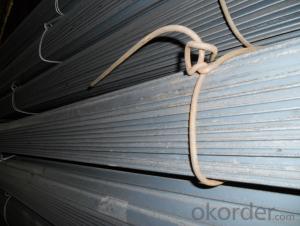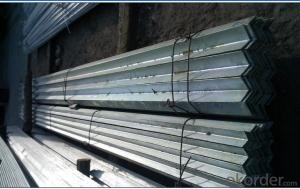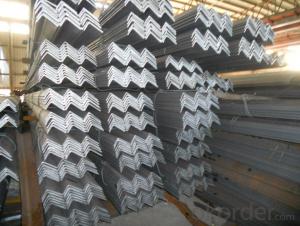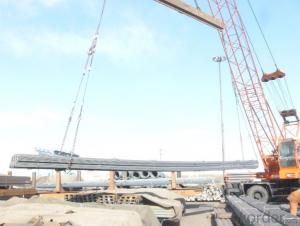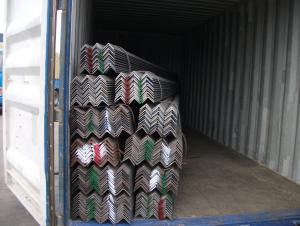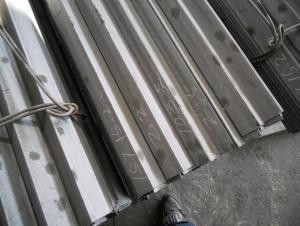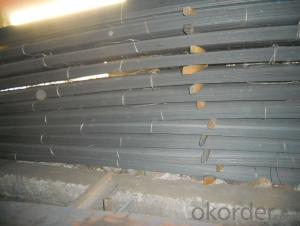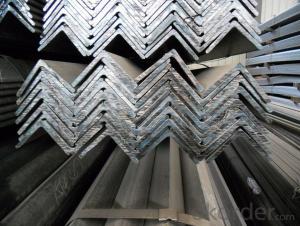Hot Rolled Carbon Steel Equal Angle with High Quality
- Loading Port:
- Tianjin
- Payment Terms:
- TT OR LC
- Min Order Qty:
- 20 m.t.
- Supply Capability:
- 1000 m.t./month
OKorder Service Pledge
OKorder Financial Service
You Might Also Like
Product Description:
OKorder is offering Hot Rolled Carbon Steel Equal Angle at great prices with worldwide shipping. Our supplier is a world-class manufacturer of steel, with our products utilized the world over. OKorder annually supplies products to European, North American and Asian markets. We provide quotations within 24 hours of receiving an inquiry and guarantee competitive prices.
Product Applications:
According to the needs of different structures, Angle can compose to different force support component, and also can be the connections between components. It is widely used in various building structures and engineering structures such as roof beams, bridges, transmission towers, hoisting machinery and transport machinery, ships, industrial furnaces, reaction tower, container frame and warehouse etc.
Product Advantages:
OKorder's Equal Angle are durable, strong, and resist corrosion.
Main Product Features:
· Premium quality
· Prompt delivery & seaworthy packing (30 days after receiving deposit)
· Corrosion resistance
· Can be recycled and reused
· Mill test certification
· Professional Service
· Competitive pricing
Product Specifications:
1. Invoicing on theoretical weight or actual weight as customer request
2. Length: 6m, 9m, 12m as following table
3. Sizes

Sizes: 25mm-250mm | ||
a*t | ||
25*2.5-4.0 | 70*6.0-9.0 | 130*9.0-15 |
30*2.5-6.6 | 75*6.0-9.0 | 140*10-14 |
36*3.0-5.0 | 80*5.0-10 | 150*10-20 |
38*2.3-6.0 | 90*7.0-10 | 160*10-16 |
40*3.0-5.0 | 100*6.0-12 | 175*12-15 |
45*4.0-6.0 | 110*8.0-10 | 180*12-18 |
50*4.0-6.0 | 120*6.0-15 | 200*14-25 |
60*4.0-8.0 | 125*8.0-14 | 250*25 |
FAQ:
Q1: Why buy Materials & Equipment from OKorder.com?
A1: All products offered byOKorder.com are carefully selected from China's most reliable manufacturing enterprises. Through its ISO certifications, OKorder.com adheres to the highest standards and a commitment to supply chain safety and customer satisfaction.
Q2: How do we guarantee the quality of our products?
A2: We have established an advanced quality management system which conducts strict quality tests at every step, from raw materials to the final product. At the same time, we provide extensive follow-up service assurances as required.
Q3: How soon can we receive the product after purchase?
A3: Within three days of placing an order, we will begin production. The specific shipping date is dependent upon international and government factors, but is typically 7 to 10 workdays.
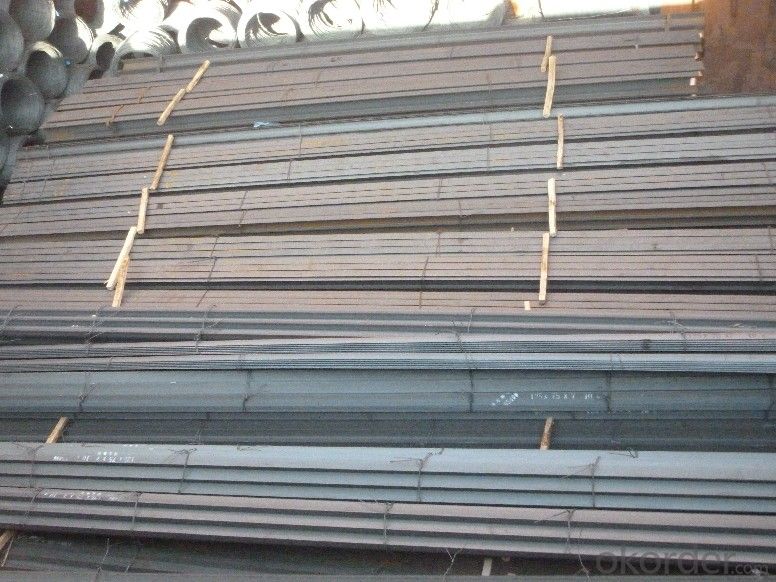
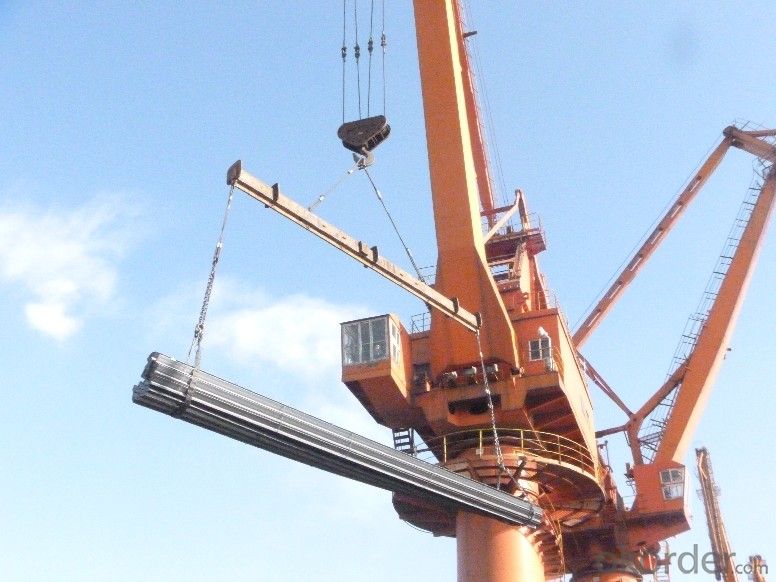
- Q: How do steel angles compare to other structural materials?
- Steel angles are a popular choice in the construction industry due to their versatility and strength. Compared to other structural materials, such as wood or aluminum, steel angles offer several advantages. Firstly, steel angles have superior strength and load-bearing capacity. They can support heavy loads and provide structural stability, making them ideal for use in buildings, bridges, and other infrastructure projects. Steel angles also have a high resistance to bending and twisting, ensuring durability and longevity in various applications. Additionally, steel angles are highly versatile. They can be easily customized and fabricated into different shapes and sizes, allowing for precise and efficient construction. This flexibility enables designers and engineers to create complex structures and achieve specific architectural requirements. Steel angles also provide excellent fire resistance compared to materials like wood. Steel is non-combustible, meaning it does not fuel the spread of fire, making it a safer option in buildings and structures. Moreover, steel angles have a high recyclability rate, making them environmentally friendly. Steel is one of the most recycled materials in the world, and using steel angles in construction contributes to sustainable building practices and reduces the demand for new raw materials. However, it is worth mentioning that steel angles can be more expensive than some other materials, such as wood or aluminum. Additionally, steel requires proper surface treatment and corrosion protection to prevent rusting and maintain its structural integrity. Overall, steel angles offer numerous advantages over other structural materials, including superior strength, versatility, fire resistance, and recyclability. These qualities make them a preferred choice in many construction projects, where durability, efficiency, and safety are paramount.
- Q: Can steel angles be used for staircase handrails?
- Yes, steel angles can be used for staircase handrails. They are commonly used due to their durability, strength, and versatility in design. Steel angles provide a sturdy support system for staircase handrails and can be customized to fit different styles and preferences.
- Q: What is the minimum thickness of a steel angle?
- The minimum thickness of a steel angle typically depends on the specific application and the structural requirements. However, it is generally recommended to have a minimum thickness of around 1/8 inch (3.175 mm) for standard steel angles.
- Q: Are steel angles suitable for balcony construction?
- Yes, steel angles are suitable for balcony construction. Steel angles are commonly used in construction due to their strength and durability. They provide excellent support and stability, making them ideal for balcony construction. Steel angles can withstand heavy loads and are resistant to weathering and corrosion, making them a reliable choice for outdoor structures like balconies. Additionally, steel angles can be easily customized and fabricated to meet specific design requirements, allowing for flexibility in balcony construction. Overall, steel angles are a popular and suitable choice for balcony construction due to their strength, durability, and versatility.
- Q: Are steel angles suitable for scaffolding?
- Certainly, scaffolding can indeed utilize steel angles. With their strength and durability, steel angles serve as an excellent option for bolstering hefty loads and ensuring stability at construction sites. By effortlessly connecting and assembling them, a steady structure for workers to reach elevated levels during construction or maintenance endeavors can be promptly established. Moreover, the versatility of steel angles permits diverse configurations and adjustments to cater to distinct project needs. Overall, steel angles are deemed as a dependable and frequently employed element within scaffolding systems.
- Q: Can steel angles be used in the construction of industrial chimneys?
- Yes, steel angles can be used in the construction of industrial chimneys. Steel angles are commonly used as structural components in various construction projects due to their strength, durability, and versatility. In the case of industrial chimneys, steel angles can be used to provide support and stability to the chimney structure. They can be incorporated into the design to reinforce the chimney's framework, particularly at the corners and joints where additional strength is required. Additionally, steel angles can also be used to create a base or foundation for the chimney, ensuring stability and preventing any potential structural issues. Overall, steel angles are a suitable choice for the construction of industrial chimneys due to their ability to withstand the high temperatures and harsh conditions associated with chimney operation.
- Q: How are steel angles measured?
- Two main dimensions are used to measure steel angles: the length of each leg and the thickness of the material. Each leg's length refers to the distance from the intersection point of the two legs to the end of each leg. This measurement is typically expressed in inches or millimeters. The material's thickness, also known as the gauge, measures the width of the steel angle. It is commonly expressed in fractions of an inch or millimeters. To provide a comprehensive measurement, steel angles are often described by combining these two dimensions. For instance, a typical specification could be "2 x 2 x 1/4," indicating that the steel angle has legs measuring 2 inches in length, a thickness of 1/4 inch, and both legs are of equal length. It's worth noting that steel angles can be measured differently depending on the specific industry or region. Metric measurements may be used in some industries, while others may prefer imperial measurements. Therefore, it's always advisable to verify the measuring standards used in a particular context to ensure accurate understanding and communication.
- Q: How do you calculate the axial compression capacity of a steel angle?
- To calculate the axial compression capacity of a steel angle, you would need to consider several factors such as the dimensions and properties of the angle, the material properties, and the boundary conditions. The calculation typically involves determining the slenderness ratio, which is the ratio of the length of the angle to its thickness. This ratio helps determine whether the angle will fail in compression or buckling. The axial compression capacity can then be calculated using relevant design codes or formulas, taking into account factors such as the yield strength of the material and any additional considerations specific to the application.
- Q: Are steel angles available in different colors?
- No, steel angles typically come in a standard metallic gray color. However, it is possible to apply various finishes or coatings to steel angles to achieve a different color or appearance. These finishes can include powder coating, paint, or galvanization, which may offer a range of colors to choose from. It is important to note that the availability of colors may vary depending on the specific manufacturer or supplier.
- Q: What are the different methods for protecting steel angles from corrosion?
- There are several methods for protecting steel angles from corrosion, including the use of protective coatings such as paint or galvanization, applying corrosion inhibitors, using sacrificial anodes, implementing cathodic protection systems, and regular maintenance and inspection of the angles to identify and address any potential corrosion issues.
Send your message to us
Hot Rolled Carbon Steel Equal Angle with High Quality
- Loading Port:
- Tianjin
- Payment Terms:
- TT OR LC
- Min Order Qty:
- 20 m.t.
- Supply Capability:
- 1000 m.t./month
OKorder Service Pledge
OKorder Financial Service
Similar products
Hot products
Hot Searches
Related keywords
